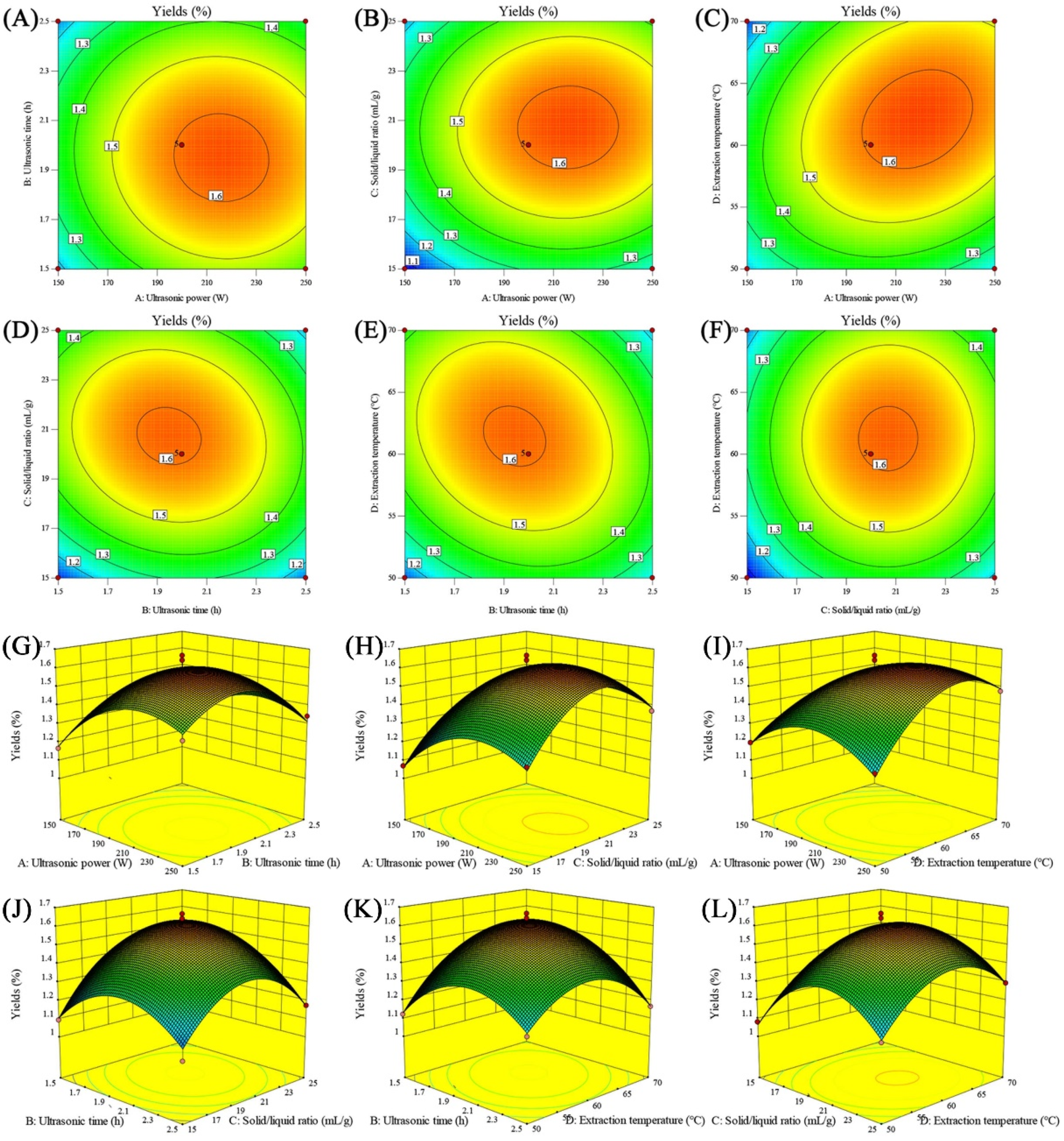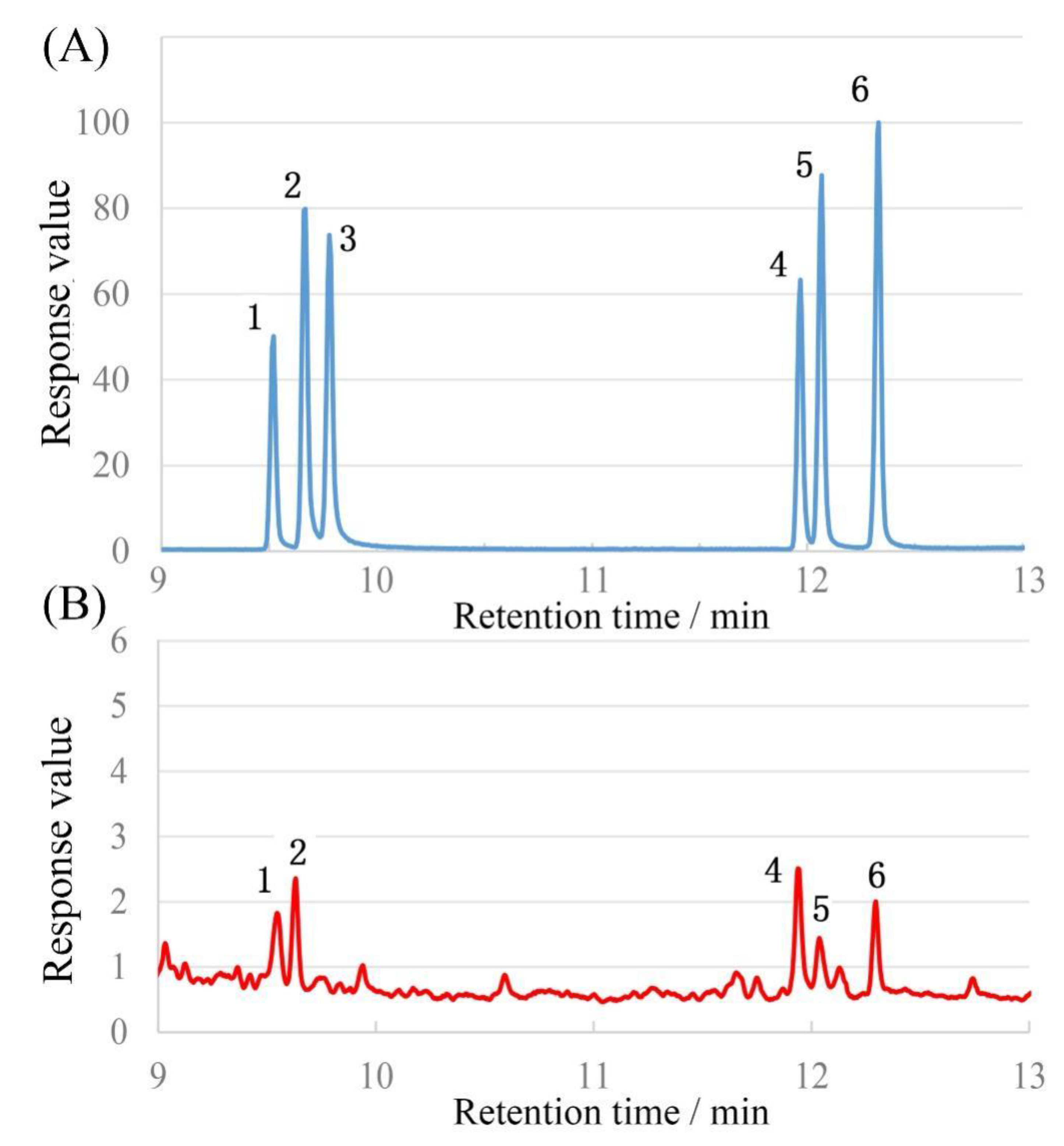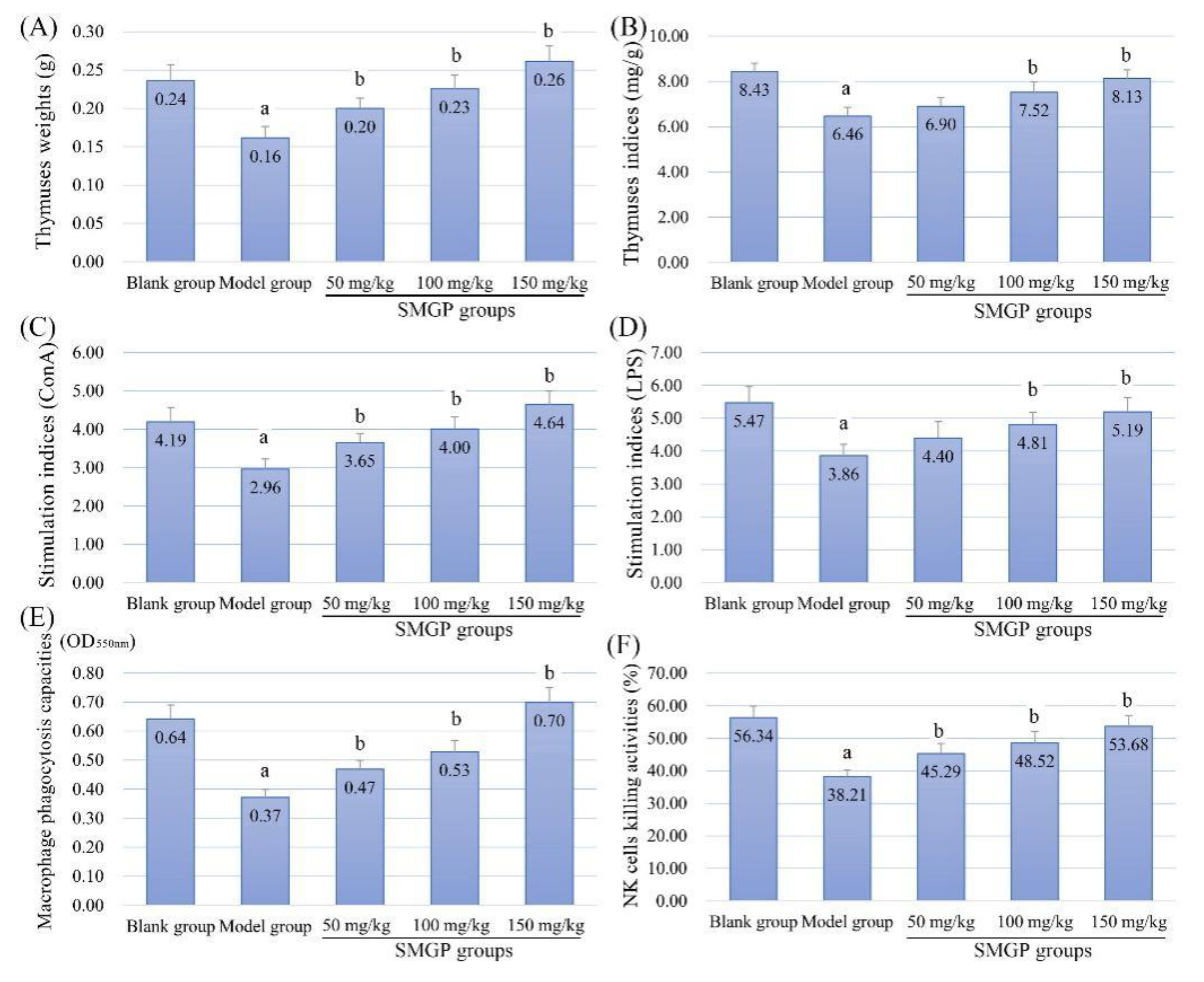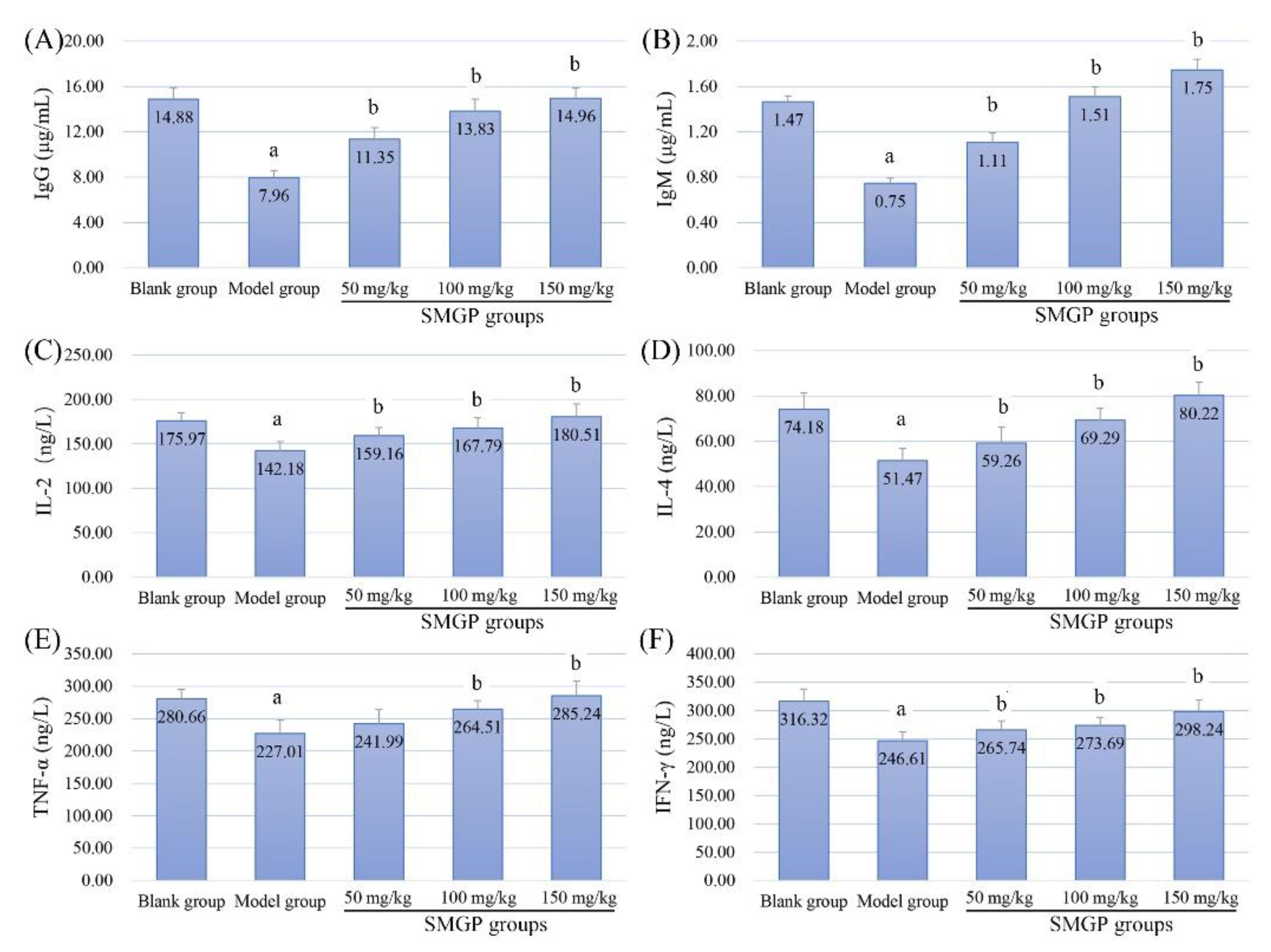Preparation, Antioxidant and Immunoregulatory Activities of a Macromolecular Glycoprotein from Salvia miltiorrhiza
Abstract
:1. Introduction
2. Materials and Methods
2.1. Materials and Regents
2.2. Preparation of SMGP
2.3. Optimization of SMGP Extraction Process
2.4. Chemical Components Determination of SMGP
2.5. Ultraviolet Scanning and Molecular Weight Detection of SMGP
2.6. Monosaccharides and Amino Acids Compositions of SMGP
2.7. Antioxidant Activity In Vitro
2.8. Animal Experiments Design
2.9. Antioxidant Effects In Vivo
2.10. Immune Cells Activities Detection
2.11. Antibodies and Cytokines Determination
2.12. Statistical Analysis
3. Results and Discussions
3.1. Optimization of SMGP Extraction
3.2. Interactive Effects Analysis
3.3. Optimized Conditions
3.4. Chemical Composition, UV, and HPGPC Analysis of SMGP
3.5. Monosaccharide Compositions of SMGP
3.6. Types and Contents of Amino Acids in SMGP
3.7. Antioxidant Activities In Vitro
3.8. Antioxidant Activities In Vivo
3.9. Thymus Indices and Immune Cell Activities
3.10. Antibody Levels and Cytokine Expressions In Sera
4. Conclusions
Author Contributions
Funding
Institutional Review Board Statement
Informed Consent Statement
Data Availability Statement
Conflicts of Interest
References
- Cai, X.; Zhang, H.; Li, T. Multi-target pharmacological mechanisms of Salvia miltiorrhiza against oral submucous fibrosis: A network pharmacology approach. Arch. Oral Biol. 2021, 126, 105131. [Google Scholar] [CrossRef] [PubMed]
- Lin, Y.-S.; Peng, W.-H.; Shih, M.-F.; Cherng, J.-Y. Anxiolytic effect of an extract of Salvia miltiorrhiza Bunge (Danshen) in mice. J. Ethnopharmacol. 2020, 264, 113285. [Google Scholar] [CrossRef]
- Chen, X.; Guo, J.; Bao, J.; Lu, J.; Wang, Y. The Anticancer Properties of Salvia Miltiorrhiza Bunge (Danshen): A Systematic Review. Med. Res. Rev. 2013, 34, 768–794. [Google Scholar] [CrossRef] [PubMed]
- Zhou, L.; Zuo, Z.; Chow, M.S.S. Danshen: An Overview of Its Chemistry, Pharmacology, Pharmacokinetics, and Clinical Use. J. Clin. Pharmacol. 2005, 45, 1345–1359. [Google Scholar] [CrossRef] [PubMed]
- Ma, S.; Zhang, D.; Lou, H.; Sun, L.; Ji, J. Evaluation of the anti-inflammatory activities of tanshinones isolated from Salvia miltiorrhiza var. alba roots in THP-1 macrophages. J. Ethnopharmacol. 2016, 188, 193–199. [Google Scholar] [CrossRef]
- Olawuyi, I.; Kim, S.R.; Hahn, D.; Lee, W.Y. Influences of combined enzyme-ultrasonic extraction on the physicochemical characteristics and properties of okra polysaccharides. Food Hydrocoll. 2019, 100, 105396. [Google Scholar] [CrossRef]
- Park, J.J.; Lee, W.Y. Anti-glycation effect of Ecklonia cava polysaccharides extracted by combined ultrasound and enzyme-assisted extraction. Int. J. Biol. Macromol. 2021, 180, 684–691. [Google Scholar] [CrossRef] [PubMed]
- Hashemifesharaki, R.; Xanthakis, E.; Altintas, Z.; Guo, Y.; Gharibzahedi, S.M.T. Microwave-assisted extraction of polysaccharides from the marshmallow roots: Optimization, purification, structure, and bioactivity. Carbohydr. Polym. 2020, 240, 116301. [Google Scholar] [CrossRef]
- Jha, A.K.; Sit, N. Comparison of response surface methodology (RSM) and artificial neural network (ANN) modelling for supercritical fluid extraction of phytochemicals from Terminalia chebula pulp and optimization using RSM coupled with desirability function (DF) and genetic algorithm (GA) and ANN with GA. Ind. Crop. Prod. 2021, 170, 113769. [Google Scholar] [CrossRef]
- Ji, H.-Y.; Liu, C.; Dai, K.-Y.; Yu, J.; Liu, A.-J.; Chen, Y.-F. The extraction, structure, and immunomodulation activities in vivo of polysaccharides from Salvia miltiorrhiza. Ind. Crop. Prod. 2021, 173, 114085. [Google Scholar] [CrossRef]
- Lara-Mondragón, C.M.; MacAlister, C.A. Partial purification and immunodetection of cell surface glycoproteins from plants. Methods Cell Biol. 2020, 160, 215–234. [Google Scholar] [CrossRef] [PubMed]
- Unione, L.; Ardá, A.; Jiménez-Barbero, J.; Millet, O. NMR of glycoproteins: Profiling, structure, conformation and interactions. Curr. Opin. Struct. Biol. 2020, 68, 9–17. [Google Scholar] [CrossRef]
- Seedevi, P.; Moovendhan, M.; Sudharsan, S.; Sivasankar, P.; Sivakumar, L.; Vairamani, S.; Shanmugam, A. Isolation and chemical characteristics of rhamnose enriched polysaccharide from Grateloupia lithophila. Carbohydr. Polym. 2018, 195, 486–494. [Google Scholar] [CrossRef] [PubMed]
- Ji, H.-Y.; Dai, K.-Y.; Liu, C.; Yu, J.; Liu, A.-J.; Chen, Y.-F. The ethanol-extracted polysaccharide from Cynanchum paniculatum: Optimization, structure, antioxidant and antitumor effects. Ind. Crop. Prod. 2021, 175, 114243. [Google Scholar] [CrossRef]
- Braun, D.A.; Street, K.; Burke, K.P.; Cookmeyer, D.L.; Denize, T.; Pedersen, C.B.; Gohil, S.H.; Schindler, N.; Pomerance, L.; Hirsch, L.; et al. Progressive immune dysfunction with advancing disease stage in renal cell carcinoma. Cancer Cell 2021, 39, 632–648.e8. [Google Scholar] [CrossRef] [PubMed]
- Kirsch-Volders, M.; Bolognesi, C.; Ceppi, M.; Bruzzone, M.; Fenech, M. Micronuclei, inflammation and auto-immune disease. Mutat. Res. Mutat. Res. 2020, 786, 108335. [Google Scholar] [CrossRef]
- de Moraes-Pinto, M.I.; Suano-Souza, F.; Aranda, C.S. Immune system: Development and acquisition of immunological competence. J. de Pediatr. 2020, 97, S59–S66. [Google Scholar] [CrossRef]
- Estevez, J.; Chen, V.; Podlaha, O.; Li, B.; Le, A.; Vutien, P.; Chang, E.T.; Rosenberg-Hasson, Y.; Jiang, Z.; Pflanz, S.; et al. Differential Serum Cytokine Profiles in Patients with Chronic Hepatitis B, C, and Hepatocellular Carcinoma. Sci. Rep. 2017, 7, 1–11. [Google Scholar] [CrossRef] [Green Version]
- Lorenzo, J.M.; Munekata, P.E.; Gómez, B.; Barba, F.J.; Mora, L.; Pérez-Santaescolástica, C.; Toldrá, F. Bioactive peptides as natural antioxidants in food products—A review. Trends Food Sci. Technol. 2018, 79, 136–147. [Google Scholar] [CrossRef]
- Ngo, D.-H.; Vo, T.-S.; Wijesekara, I.; Kim, S.-K. Biological activities and potential health benefits of bioactive peptides derived from marine organisms. Int. J. Biol. Macromol. 2012, 51, 378–383. [Google Scholar] [CrossRef]
- Lemiale, V.; Yvin, E.; Kouatchet, A.; Mokart, D.; Demoule, A.; Dumas, G. Oxygenation strategy during acute respiratory failure in immunocompromised patients. J. Intensiv. Med. 2021, 1, 81–89. [Google Scholar] [CrossRef]
- Ebokaiwe, A.P.; Obasi, D.O.; Njoku, R.C.C.; Osawe, S.; Olusanya, O.; Kalu, W.O. Cyclophosphamide instigated hepatic-renal oxidative/inflammatory stress aggravates immunosuppressive indoleamine 2,3-dioxygenase in male rats: Abatement by quercetin. Toxicology 2021, 464, 153027. [Google Scholar] [CrossRef] [PubMed]
- DuBois, M.; Gilles, K.A.; Hamilton, J.K.; Rebers, P.A.; Smith, F. Colorimetric method for determination of sugars and related substances. Anal. Chem. 1956, 28, 350–356. [Google Scholar] [CrossRef]
- Barbosa, H.; Slater, N.K.; Marcos, J.C. Protein quantification in the presence of poly(ethylene glycol) and dextran using the Bradford method. Anal. Biochem. 2009, 395, 108–110. [Google Scholar] [CrossRef] [PubMed]
- Bitter, T.; Muir, H.M. A modified uronic acid carbazole reaction. Anal. Biochem. 1962, 4, 330–334. [Google Scholar] [CrossRef]
- Yu, J.; Ji, H.-Y.; Liu, C.; Liu, A.-J. The structural characteristics of an acid-soluble polysaccharide from Grifola frondosa and its antitumor effects on H22-bearing mice. Int. J. Biol. Macromol. 2020, 158, 1288–1298. [Google Scholar] [CrossRef]
- Yu, J.; Ji, H.; Yang, Z.; Liu, A. Relationship between structural properties and antitumor activity of Astragalus polysaccharides extracted with different temperatures. Int. J. Biol. Macromol. 2018, 124, 469–477. [Google Scholar] [CrossRef]
- Mummaleti, G.; Sarma, C.; Kalakandan, S.; Sivanandham, V.; Rawson, A.; Anandharaj, A. Optimization and extraction of edible microbial polysaccharide from fresh coconut inflorescence sap: An alternative substrate. LWT 2020, 138, 110619. [Google Scholar] [CrossRef]
- Solmaz, H.; Ardebili, S.M.S.; Calam, A.; Yılmaz, E.; Ipci, D. Prediction of performance and exhaust emissions of a CI engine fueled with multi-wall carbon nanotube doped biodiesel-diesel blends using response surface method. Energy 2021, 227, 120518. [Google Scholar] [CrossRef]
- Yu, J.; Dong, X.-D.; Jiao, J.-S.; Yu, S.-S.; Ji, H.-Y.; Liu, A.-J.; Chen, Y. Extraction, purification, and biological activities in vivo of a novel fructose-rich polysaccharide from Codonopsis pilosula. Ind. Crop. Prod. 2021, 176, 114309. [Google Scholar] [CrossRef]
- Bu, X.; Xu, Y.; Zhao, M.; Li, D.; Zou, J.; Wang, L.; Bai, J.; Yang, Y. Simultaneous extraction of polysaccharides and polyphenols from blackcurrant fruits: Comparison between response surface methodology and artificial neural networks. Ind. Crop. Prod. 2021, 170, 113682. [Google Scholar] [CrossRef]
- Glasauer, A.; Chandel, N.S. Targeting antioxidants for cancer therapy. Biochem. Pharmacol. 2014, 92, 90–101. [Google Scholar] [CrossRef] [PubMed]
- Liou, G.-Y.; Storz, P. Reactive oxygen species in cancer. Free Radic. Res. 2010, 44, 479–496. [Google Scholar] [CrossRef] [PubMed] [Green Version]
- Lv, Y.; Glahn, R.P.; Hebb, R.L.; Rizvi, S.S. Physico-chemical properties, phytochemicals and DPPH radical scavenging activity of supercritical fluid extruded lentils. LWT 2018, 89, 315–321. [Google Scholar] [CrossRef]
- Abdullah, S.S.S.; Mazlan, A.N. Quantification of polyphenols and antioxidant activity in several herbal and green tea products in Malaysia. Mater. Today Proc. 2020, 31, A106–A113. [Google Scholar] [CrossRef]
- Yin, D.; Sun, X.; Li, N.; Guo, Y.; Tian, Y.; Wang, L. Structural properties and antioxidant activity of polysaccharides extracted from Laminaria japonica using various methods. Process Biochem. 2021, 111, 201–209. [Google Scholar] [CrossRef]
- Han, Y.; Zhao, M.; Ouyang, K.; Chen, S.; Zhang, Y.; Liu, X.; An, Q.; Zhao, Z.; Wang, W. Sulfated modification, structures, antioxidant activities and mechanism of Cyclocarya paliurus polysaccharides protecting dendritic cells against oxidant stress. Ind. Crop. Prod. 2021, 164, 113353. [Google Scholar] [CrossRef]
- Huo, X.-Z.; Wang, X.; Yang, R.; Qu, L.-B.; Zeng, H.-J. Studies on the effect of a Fupenzi glycoprotein on the fibrillation of bovine serum albumin and its antioxidant activity. Spectrochim. Acta Part A Mol. Biomol. Spectrosc. 2020, 237, 118387. [Google Scholar] [CrossRef]
- Khosravi, M.; Poursaleh, A.; Ghasempour, G.; Farhad, S.; Najafi, M. The effects of oxidative stress on the development of atherosclerosis. Biol. Chem. 2018, 400, 711–732. [Google Scholar] [CrossRef]
- Olsvik, P.; Kristensen, T.; Waagbo, R.; Rosseland, B.; Tollefsen, K.-E.; Baeverfjord, G.; Berntssen, M. mRNA expression of antioxidant enzymes (SOD, CAT and GSH-Px) and lipid peroxidative stress in liver of Atlantic salmon (Salmo salar) exposed to hyperoxic water during smoltification. Comp. Biochem. Physiol. Part C Toxicol. Pharmacol. 2005, 141, 314–323. [Google Scholar] [CrossRef]
- Alyethodi, R.R.; Sirohi, A.S.; Karthik, S.; Tyagi, S.; Perumal, P.; Singh, U.; Sharma, A.; Kundu, A. Role of seminal MDA, ROS, and antioxidants in cryopreservation and their kinetics under the influence of ejaculatory abstinence in bovine semen. Cryobiology 2021, 98, 187–193. [Google Scholar] [CrossRef] [PubMed]
- YouGuo, C.; ZongJi, S.; XiaoPing, C. Modulatory effect of Ganoderma lucidum polysaccharides on serum antioxidant enzymes activities in ovarian cancer rats. Carbohydr. Polym. 2009, 78, 258–262. [Google Scholar] [CrossRef]
- Li, M.-Y.; Zhu, X.-M.; Niu, X.-T.; Chen, X.-M.; Tian, J.-X.; Kong, Y.-D.; Zhang, D.-M.; Zhao, L.; Wang, G.-Q. Effects of dietary Allium mongolicum Regel polysaccharide on growth, lipopolysaccharide-induced antioxidant responses and immune responses in Channa argus. Mol. Biol. Rep. 2019, 46, 2221–2230. [Google Scholar] [CrossRef] [PubMed]
- Zhu, X.-M.; Liu, X.-Y.; Xia, C.-G.; Li, M.-Y.; Niu, X.-T.; Wang, G.-Q.; Zhang, D.-M. Effects of dietary Astragalus Propinquus Schischkin polysaccharides on growth performance, immunological parameters, antioxidants responses and inflammation-related gene expression in Channa argus. Comp. Biochem. Physiol. Part C Toxicol. Pharmacol. 2021, 249, 109121. [Google Scholar] [CrossRef]
- Mizui, M. Natural and modified IL-2 for the treatment of cancer and autoimmune diseases. Clin. Immunol. 2018, 206, 63–70. [Google Scholar] [CrossRef]
- Suzuki, A.; Leland, P.; Joshi, B.H.; Puri, R.K. Targeting of IL-4 and IL-13 receptors for cancer therapy. Cytokine 2015, 75, 79–88. [Google Scholar] [CrossRef]
- Dash, S.; Sahu, A.K.; Srivastava, A.; Chowdhury, R.; Mukherjee, S. Exploring the extensive crosstalk between the antagonistic cytokines- TGF-β and TNF-α in regulating cancer pathogenesis. Cytokine 2020, 138, 155348. [Google Scholar] [CrossRef]
- Todorović-Raković, N. The role of cytokines in the evolution of cancer: IFN-γ paradigm. Cytokine 2021, 151, 155442. [Google Scholar] [CrossRef]
- Ren, L.; Zhang, J.; Zhang, T. Immunomodulatory activities of polysaccharides from Ganoderma on immune effector cells. Food Chem. 2020, 340, 127933. [Google Scholar] [CrossRef]
- Han, C.; Wang, X.; Zhang, D.; Wei, Y.; Cui, Y.; Shi, W.; Bao, Y. Synergistic use of florfenicol and Salvia miltiorrhiza polysaccharide can enhance immune responses in broilers. Ecotoxicol. Environ. Saf. 2021, 210, 111825. [Google Scholar] [CrossRef]






| A | B | C | D | Yields | ||
|---|---|---|---|---|---|---|
| Run | Ultrasonic Power | Ultrasonic Time | Solid/Liquid Ratio | Extraction Temperature | Actual Value | Predicted Value |
| W | h | mL/g | °C | % | % | |
| 1 | 150 | 1.5 | 20 | 60 | 1.17 | 1.18 |
| 2 | 250 | 1.5 | 20 | 60 | 1.38 | 1.41 |
| 3 | 150 | 2.5 | 20 | 60 | 1.2 | 1.19 |
| 4 | 250 | 2.5 | 20 | 60 | 1.34 | 1.31 |
| 5 | 200 | 2 | 15 | 50 | 1.08 | 1.06 |
| 6 | 200 | 2 | 25 | 50 | 1.17 | 1.17 |
| 7 | 200 | 2 | 15 | 70 | 1.18 | 1.15 |
| 8 | 200 | 2 | 25 | 70 | 1.29 | 1.29 |
| 9 | 150 | 2 | 20 | 50 | 1.2 | 1.22 |
| 10 | 250 | 2 | 20 | 50 | 1.22 | 1.21 |
| 11 | 150 | 2 | 20 | 70 | 1.08 | 1.14 |
| 12 | 250 | 2 | 20 | 70 | 1.48 | 1.49 |
| 13 | 200 | 1.5 | 15 | 60 | 1.09 | 1.1 |
| 14 | 200 | 2.5 | 15 | 60 | 1.08 | 1.14 |
| 15 | 200 | 1.5 | 25 | 60 | 1.39 | 1.33 |
| 16 | 200 | 2.5 | 25 | 60 | 1.17 | 1.18 |
| 17 | 150 | 2 | 15 | 60 | 1.07 | 1.06 |
| 18 | 250 | 2 | 15 | 60 | 1.25 | 1.24 |
| 19 | 150 | 2 | 25 | 60 | 1.14 | 1.17 |
| 20 | 250 | 2 | 25 | 60 | 1.37 | 1.39 |
| 21 | 200 | 1.5 | 20 | 50 | 1.12 | 1.13 |
| 22 | 200 | 2.5 | 20 | 50 | 1.2 | 1.19 |
| 23 | 200 | 1.5 | 20 | 70 | 1.38 | 1.38 |
| 24 | 200 | 2.5 | 20 | 70 | 1.16 | 1.17 |
| 25 | 200 | 2 | 20 | 60 | 1.59 | 1.61 |
| 26 | 200 | 2 | 20 | 60 | 1.67 | 1.61 |
| 27 | 200 | 2 | 20 | 60 | 1.64 | 1.61 |
| 28 | 200 | 2 | 20 | 60 | 1.57 | 1.61 |
| 29 | 200 | 2 | 20 | 60 | 1.56 | 1.61 |
| Sources | Sum of | Degree of Freedom | Mean | F | p-Value | Significance |
|---|---|---|---|---|---|---|
| Squares | Square | Value | Prob > F | |||
| Model | 0.92 | 14 | 0.066 | 39.34 | <0.0001 | Significant |
| A | 0.12 | 1 | 0.12 | 70.08 | <0.0001 | |
| B | 0.012 | 1 | 0.012 | 7.07 | 0.0187 | |
| C | 0.049 | 1 | 0.049 | 29.49 | <0.0001 | |
| D | 0.029 | 1 | 0.029 | 17.63 | 0.0009 | |
| AB | 1.27 × 10−3 | 1 | 1.27 × 10−3 | 0.76 | 0.3973 | |
| AC | 5.02 × 10−4 | 1 | 5.02 × 10−4 | 0.3 | 0.5924 | |
| AD | 0.033 | 1 | 0.033 | 19.81 | 0.0005 | |
| BC | 0.01 | 1 | 0.01 | 6.08 | 0.0272 | |
| BD | 0.022 | 1 | 0.022 | 12.96 | 0.0029 | |
| CD | 1.04 × 10−4 | 1 | 1.04 × 10−4 | 0.062 | 0.8066 | |
| A2 | 0.16 | 1 | 0.16 | 97.13 | <0.0001 | |
| B2 | 0.22 | 1 | 0.22 | 132.53 | <0.0001 | |
| C2 | 0.36 | 1 | 0.36 | 212.71 | <0.0001 | |
| D2 | 0.26 | 1 | 0.26 | 152.64 | <0.0001 | |
| Residual | 0.023 | 14 | 1.67 × 10−3 | |||
| Lack of Fit | 0.015 | 10 | 1.52 × 10−3 | 0.75 | 0.6792 | not significant |
| Pure Error | 8.17 × 10−3 | 4 | 2.04 × 10−3 | |||
| Cor Total | 0.94 | 28 | ||||
| R2 | 0.9752 | Adj R2 | 0.9504 | |||
| Pred R2 | 0.8935 | C.V. % | 3.18 |
| Amino Acids | Abbreviations | Contents (%) | Amino Acids | Abbreviations | Contents (%) |
|---|---|---|---|---|---|
| Glutamic acid | Glu | 12.97% | Leucine | Leu | 5.08% |
| Valine | Val | 12.03% | Isoleucine | Ile | 4.89% |
| Aspartic acid | Asp | 10.71% | Glycine | Gly | 4.32% |
| Phenylalanine | Phe | 10.34% | Alanine | Ala | 3.95% |
| Threonine | Thr | 8.83% | Arginine | Arg | 3.01% |
| Serine | Ser | 6.77% | Lysine | Lys | 2.63% |
| Proline | Pro | 6.20% | Histidine | His | 1.50% |
| Tyrosine | Tyr | 5.64% | Methionine | Met | 1.13% |
| Groups | SOD (Unit) | GSH-Px (Unit) | MDA (nmol) | T-AOC (Unit) | |
|---|---|---|---|---|---|
| Blank group | 148.53 ± 8.35 | 355.47 ± 24.37 | 4.39 ± 0.37 | 34.24 ± 2.15 | |
| Model group | 124.26 ± 9.26 a | 298.38 ± 18.42 a | 6.69 ± 0.47 a | 33.86 ± 1.87 | |
| SMGP groups | 50 mg/kg | 139.48 ± 7.18 b | 325.56 ± 19.49 b | 5.63± 0.49 b | 35.02 ± 1.49 |
| 100 mg/kg | 153.37 ± 9.05 b | 342.48 ± 21.47 b | 5.03 ± 0.32 b | 33.84 ± 2.16 | |
| 150 mg/kg | 166.58 ± 8.79 b | 367.16 ± 22.21 b | 4.17 ± 0.33 b | 34.93 ± 1.24 | |
Publisher’s Note: MDPI stays neutral with regard to jurisdictional claims in published maps and institutional affiliations. |
© 2022 by the authors. Licensee MDPI, Basel, Switzerland. This article is an open access article distributed under the terms and conditions of the Creative Commons Attribution (CC BY) license (https://creativecommons.org/licenses/by/4.0/).
Share and Cite
Ji, H.-Y.; Dai, K.-Y.; Liu, C.; Yu, J.; Jia, X.-Y.; Liu, A.-J. Preparation, Antioxidant and Immunoregulatory Activities of a Macromolecular Glycoprotein from Salvia miltiorrhiza. Foods 2022, 11, 705. https://doi.org/10.3390/foods11050705
Ji H-Y, Dai K-Y, Liu C, Yu J, Jia X-Y, Liu A-J. Preparation, Antioxidant and Immunoregulatory Activities of a Macromolecular Glycoprotein from Salvia miltiorrhiza. Foods. 2022; 11(5):705. https://doi.org/10.3390/foods11050705
Chicago/Turabian StyleJi, Hai-Yu, Ke-Yao Dai, Chao Liu, Juan Yu, Xiao-Yu Jia, and An-Jun Liu. 2022. "Preparation, Antioxidant and Immunoregulatory Activities of a Macromolecular Glycoprotein from Salvia miltiorrhiza" Foods 11, no. 5: 705. https://doi.org/10.3390/foods11050705





